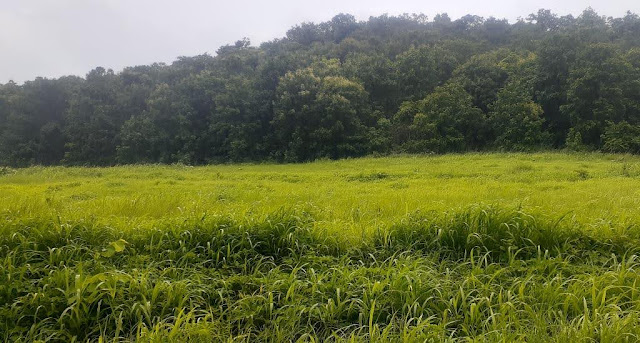Melghat Tiger Reserve, Amravati – The Tiger Reserve
Melghat Tiger Reserve is located on the southern offshoot of the Satpura
Hill Range in Central India, called Gavilgarh Hill. The main ridge, called
Gavilgarh Ridge, runs east-west forms the southwestern boundary of the reserve.
It is a flat plateau on top, descending in abrupt and sharp precipitous scarps
on both sides and then steep slopes down to narrow valleys. These abrupt variations
in altitude, aspect and gradient are seen throughout the reserve. The plateau
was earlier used for agriculture.

This ridge has its highest point at Vairat (1178 m. above msl.). Melghat
has rugged topography with only a few entry points and is naturally protected
from the outside interference. The Makhala, Chikhaldara, Chiladari, Patulda and
Gugamal are the large plateaux amidst rugged terrain. The Melghat Tiger Reserve
is divided into Sipna, Gugamal and Akot Wildlife Division, administratively.
Presently, the total area of the reserve is around
1677 km2. The reserve is a catchment area for five major rivers namely
Khandu, Khapra, Sipna, Gadga and Dolar.
These all rivers are tributaries of the river Tapti. The Tapti
River flows through the northern part of Melghat Tiger Reserve and forms
the boundary of the reserve together with the Gawilghur ridge of
the Satpura Range. The sudden slope of Melghat forms the part of catchment
of river Purna. The three major tributaries originating from Melghat region and
draining into river Purna are Chandrabhaga, Adnani and Wan.
Flora:
The habitat is a typical representative of the Central Indian Highland,
forming a part of the Deccan Peninsula- Central Indian Highland
biogeographically. The forest is southern tropical dry deciduous in nature,
dominated by teak (Tectona grandis) and bamboo. The other tree species found in
the forest are Tiwas, Bija, Haldu, Saja, Dhawda, Ain, Moha, Tendu, Achar, Amla,
Behada, Bhilwa, Bor, Mango, Khair, Jamun, Apta, Bel and Kulu.
There are patches of semi-evergreen and moist deciduous forests. There are
grassy meadows throughout the reserve, especially on the hilltops. There are
many species of orchids, ferns, grasses, and other herbs. The common epiphytic
orchids are Aerides, Rhynchostylis and Vanda. Ceropegia
odorata, an extremely rare species, is found in this area. More than 769
species of plants have been recorded in the reserve.
Fauna:
The faunal
diversity of this reserve includes 30 species of reptiles, 74 of butterflies,
23 of fish, 5 species of amphibians and 26 species of spiders. The main fauna
found in this reserve are Bengal tiger, Indian leopard, sloth bear,
dhole, Indian jackal, sambar, gaur, barking deer,
nilgai, chital, chausingha, honey badger, flying squirrel, wild
boar, langur, rhesus monkey, Indian porcupine, Indian
pangolin, mouse deer, python, smooth-coated otter and black-naped
hare. The Caracal is also reported here, along with many other smaller cats. This reserve has 252 species of birds.

Some of
them are Fairy Bluebird, Great Black Woodpecker, Stork-billed Kingfisher, Black-capped
Kingfisher, Little Green Heron, Black-crowned Night Heron, Sparrowhawk, Crested
Bunting, Grey jungle fowl, Indian Peafowl, Grey Francolin, Painted Francolin,
Red Spurfowl, Greater Racket-tailed Drongo, White-bellied Drongo, Indian Grey
Hornbill, White-naped Woodpecker, Chestnut-bellied Nuthatch, Indian Pitta,
Emerald Dove, Oriental Turtle Dove, Sirkeer Malkoha, Malabar Whistling Thrush,
Orange-headed Thrush, Indian Scimitar Babbler, Black-hooded Oriole, Large
Cuckoo shrike, Scarlet Minivet, Verditer Flycatcher, Asian Paradise-flycatcher,
Crested Bunting, crested serpent Eagle, Oriental Honey-buzzard, Eurasian Hobby,
Bonelli's Eagle, Mottled Wood Owl and Jungle Owlet.
Tribals:
There are more than ten villages in the core area in Sipna and Gugamal
Wildlife Division. There are no villages in the Akot division. There are 61
villages in the reserve, all outside the core area. 22 are in the buffer
zone and 39 in the Multiple Use Area (MUA). The inhabitants are mainly
tribal, largely of the Korku tribe (80 %) and others like Gond,
Nihal, Balai, Gaolan, Gawali, Halbi, Wanjari, and Maratha. All inhabitants
depend on the forest for bona fide domestic needs of firewood, timber, fodder,
medicinal plants, and non-timber forest products like fruit, flowers, gum, and
medicinal plants. Their main source of income is from labour and rainy season
agriculture. They augment their income by collecting non-timber forest products
like mahuali, flowers, seeds, charoli, gumcula, dhawada,
tendu-leaves, and musali (a medicinal plant).


.jpg)



















.jpg)





.jpg)
.jpg)




.jpg)


